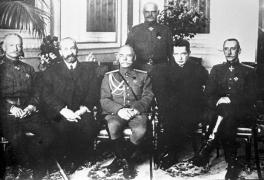First Revolutionary Government
Initially, the Provisional Government consisted of 11 ministers (later the number increased).
The idea to form a government composed of the Duma opposition first appeared in 1915. That year several moderate opposition factions consolidated and formed a progressive bloc. The Progressives called for a “government of confidence” that would be accountable to the Duma.
After the Revolution, members of the progressive bloc formed a transitional, provisional government led by Prince Georgy Lvov. Out of 11 ministers only Alexander Kerensky, minister of justice, was a member of the Socialist Revolutionary Party. The First Revolutionary Government was internationally recognized and adopted several crucial decrees, granting amnesty, abolishing capital punishment, disbanding the secret police and replacing the police with militia.
